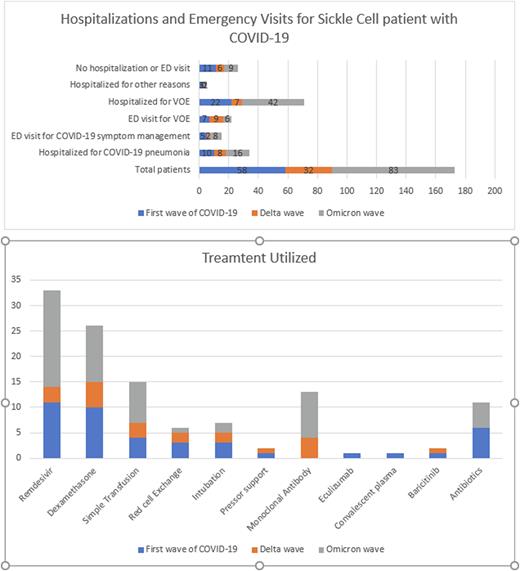Abstract
The Georgia Comprehensive Sickle Cell (SC) center at Grady health system is the largest adult comprehensive sickle cell center in the United States and has the first 24/7 acute care unit for management of sickle cell vaso-occlusive events (VOE). in 2019, the center provided around 3000 sickle cell clinic visits and 4000 acute care visits. When the COVID-19 pandemic reached the US, the SC center had seen a precipitous drop in the number of both clinic and acute care visits as local and state regulations for lockdown were passed. On the two-year anniversary for the COVID-19 pandemic, we are submitting this report of all the COVID-19 cases at a single adult center for sickle cell disease.
Since the start of the pandemic, we have been tracking any COVID-19 cases reported in the patient population the SC center follows. Out of 1343 patients currently following in the center, 173 patients contracted COVID-19 between March 2020 and February 2022, and were tracked in the clinical database under IRB approval.
The results show that of the 173 patients, 85 were female and 89 were male. By genotype, 62% of patients were SS, 29% were SC and 9% were Sβ+ thalassemia or Sβ0 thalassemia. 32% of patients were on hydroxyurea for disease modification with the majority of them being of the SS genotype and 45% had elevated fetal hemoglobin determined by a percentage fetal hemoglobin above 5% by hemoglobin electrophoresis. Chronic pain was defined in the patients experiencing daily pain episodes for more than 4 days a week for the last 3 months and calculation of daily morphine equivalents was reported based on the clinic follow-ups and the narcotic database utilization. 35% of the SC patients had chronic pain and the median morphine equivalents was 90 mg daily with a range between 45 and 225mg.
On evaluating the rate of emergency department (ED) visits or hospitalizations for the sickle cell patients with COVID-19, 85% of patients had either an ED visit or hospitalization. 54% of the SC patients had the reason for the visit related to VOE and 29% had the reason related to COVID-19 primarily. 15% of SC patients were not seen in any emergency setting or required any hospitalization.
22% of the patients had lung findings on imaging. The treatment utilized for the patients was most commonly Remdesivir in 33, dexamethasone in 26, red cell products in 21 and monoclonal antibody in 13 patients.
Of the 3 deaths reported, 2 happened early in the pandemic. One patient had presented in June 2020 with VOE and was found to have bilateral lung opacities but was asymptomatic and was discharged home to return few days later with clinical picture of multi-organ failure (MOF) for which a red cell erythrocytapheresis was attempted to no avail. The second patient had presented in July 2020 with COVID-19 pneumonia and was treated with Remdesivir and convalescent plasma to no avail after development of MOF and ARDS. The third death occurred in August 2021 during the delta variant wave and the patient was hospitalized for COVID-19 pneumonia and had initial improvement after initial treatment but after worsened lung findings, ARDS developed followed by MOF.
Several reports from different centers have been published regarding the rate of COVID-19 related mortality and morbidity in sickle cell disease. The Grady comprehensive sickle cell center experience differs in the fact that 63 out of 173 (36%) patients who had contracted COVID-19 required treatment and 3 of those 63 had died. In fact, the deaths occurred early in the course of the pandemic in June and July 2020 respectively and since then, the rate of complicated COVID-19 hospitalizations has decreased with better treatment available. No deaths were registered during the omicron wave and 1 death was registered during the delta wave. In addition, the timeline for the COVID-19 cases reported fits the population timeline of peaks respectively happening in the summer of 2020, winter of 2021, summer of 2021 and winter of 2021. During the initial peak, we have noted a decrease in the number of clinic and acute care visits respectively. This was anticipated given the statewide lockdown that was implemented. To circumvent that, the SC center resorted to virtual visits utilization to deliver the needed healthcare visits to the patients. This measure has aided in protecting patients against COVID-19 during the multiple COVID-19 peaks occurring in the last 2 years and has accordingly reduced the mortality and morbidity of the patient population.
Disclosures
El Rassi:Novartis, Forma Therapeutics, Agios: Membership on an entity's Board of Directors or advisory committees, Research Funding.
Author notes
Asterisk with author names denotes non-ASH members.


This feature is available to Subscribers Only
Sign In or Create an Account Close Modal